Key points:
- Annual reviews prevent pay inequities and address gender, performance, and market-based salary gaps.
- Budget allocation typically ranges 3-5% of payroll across inflation, market adjustment, and merit increases.
- Calibration meetings average 3 minutes per employee when properly structured and timeboxed.
- 12-week process from planning to implementation ensures thorough evaluation and smooth rollout (but it can vary a lot depending on the company size).
- Templates reduce review time by 60% compared to building spreadsheets from scratch.
- Structured approach beats guesswork with clear methodology for fair, defensible compensation decisions.
We know you were looking for best practices for this year's annual compensation review. Which is why we hosted a live workshop and put together a guide for you! Whereas a manual process could prove complex, an automated compensation system will be more fair and efficient while giving credibility to individual outcomes.
A compensation review process is a systematic evaluation of employee salaries against market rates and internal equity standards. This structured approach ensures fair compensation across your organisation within your company budget and regulatory compliance. When done right, your boss is happy, your employees are fairly compensated (and away from job boards), and regulatory compliance is someone else’s problem.
However, doing this manually can be very tedious and often inaccurate. Thankfully, we know exactly what you need!
We’ll get into it, but first…
What is a compensation review process?
A compensation review process, also known as a "salary review process," is one of the concrete applications of your Compensation philosophy and policy.
In short, its goal is to evaluate employee pay packages for fairness and competitiveness. Reviews ensure salaries align with market standards and company goals. The process prevents pay disparities based on gender, performance, or market position.
There are lots of different ways to perform your compensation review, but eventually, the exercise can be summarised as follows: a review of the company’s compensation structure to evaluate whether employees are paid fairly based on your internal guidelines and equity, and market alignment.
Doing this review regularly will mitigate potential inequities, whether they are based on gender, performance, or compared to the market.
We recommend running your salary review at least once a year. Lately, more companies have been switching to reviews every six months to be sure to evolve as quickly as the employment market.
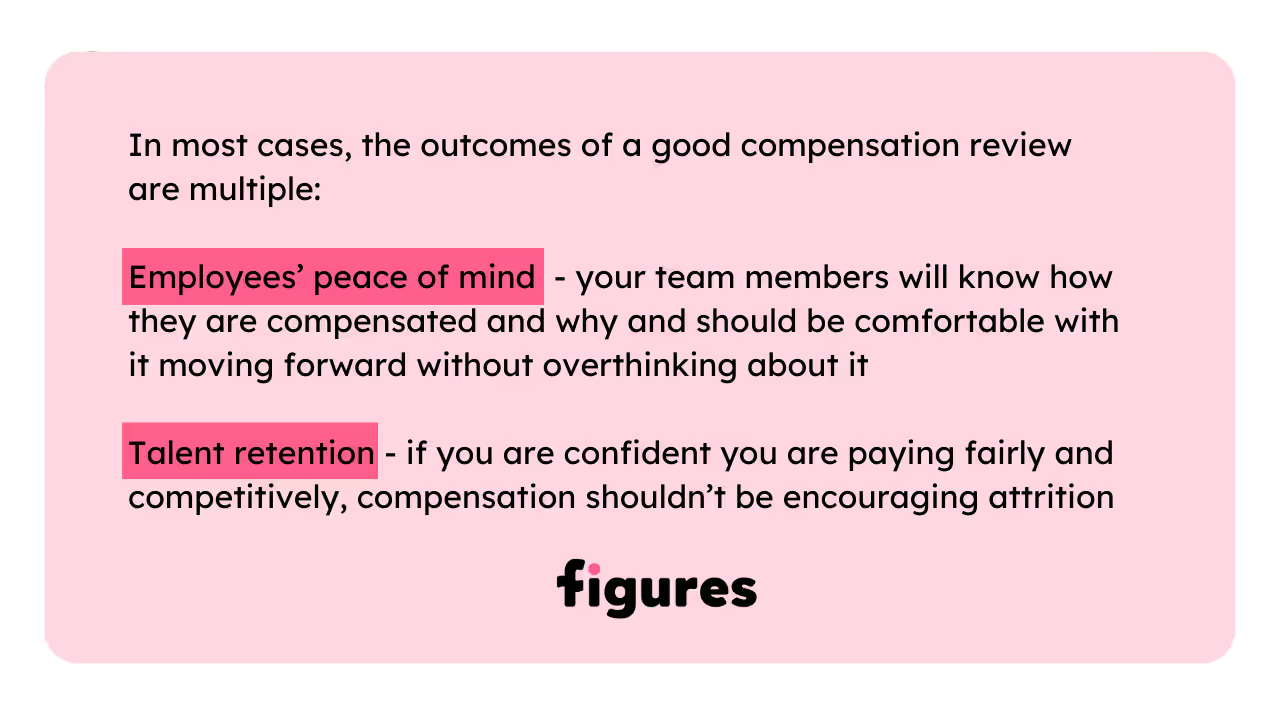
Before diving into the process itself, let's explore the different types of templates available to support your compensation review.
Types of compensation review templates
Not all compensation reviews are created equal, and neither are the templates that support them. Here's what you're usually working with:
Most HR teams end up juggling multiple template types throughout their review cycle. To help you out, we created a special comprehensive template, which combines all these elements into one streamlined system – but more on that when we get to tools.
The compensation review process timeline
A salary review flowchart visualises the compensation decision process. Think of it as your treasure map through what can feel like a Greek tragedy-level of a maze with spreadsheets, meetings, and delicate conversations.
The process follows five core phases:
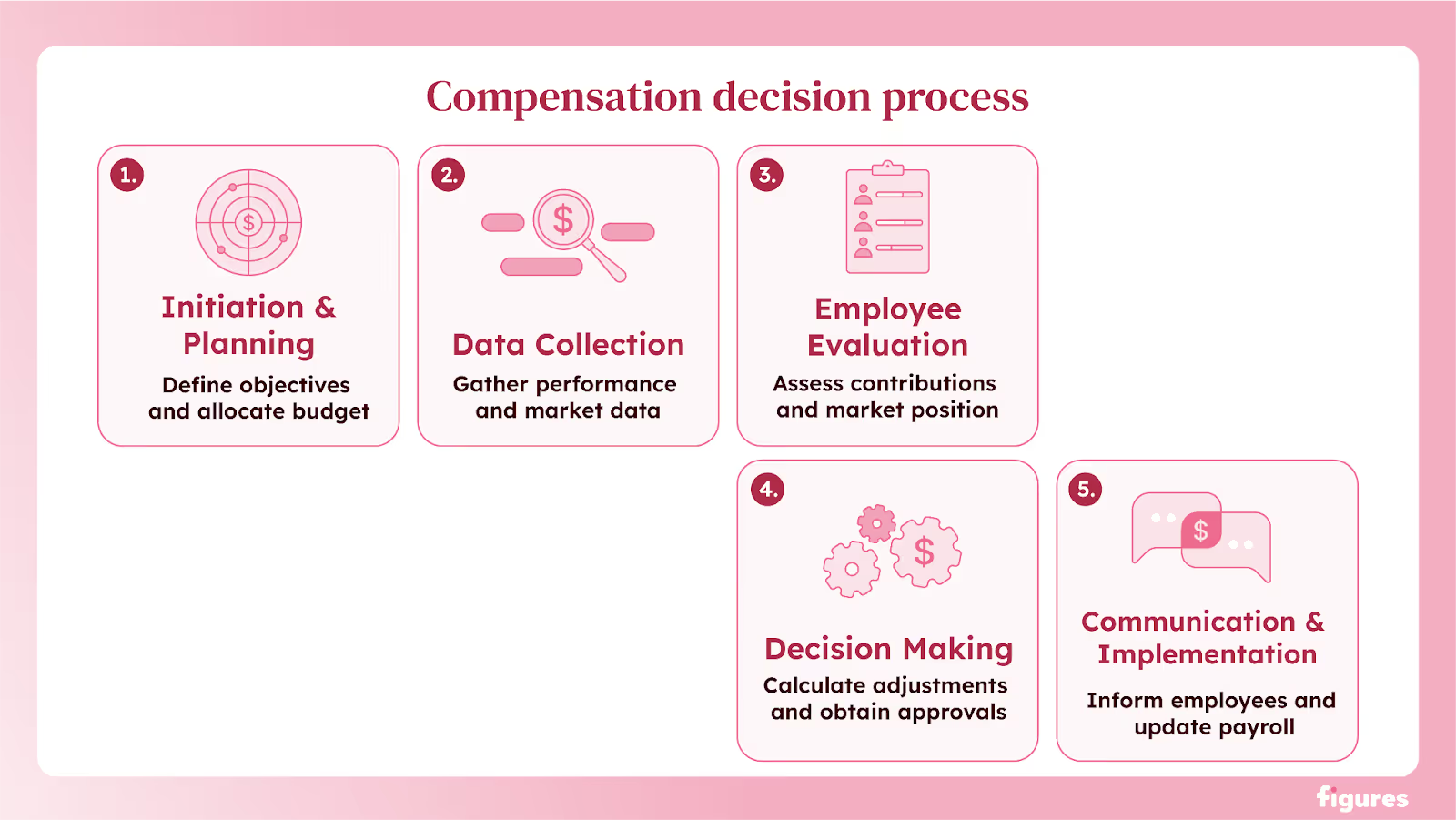
- Initiation & planning: Define objectives and allocate budget (typically takes 2-3 weeks).
- Data collection: Gather performance and market data (1-2 weeks of chasing managers for input).
- Employee evaluation: Assess contributions and market position (the longest phase at 4-6 weeks).
- Decision making: Calculate adjustments and obtain approvals (2-3 weeks of calibration meetings).
- Communication & implementation: Inform employees and update payroll (final 2-3 weeks).
Each phase builds on the previous one, which is why skipping steps or rushing through early phases usually creates chaos later. You can't make good compensation decisions without solid data, and you can't communicate those decisions effectively without proper planning.
The entire cycle typically runs 12-14 weeks from start to finish – longer if you're doing this manually, shorter if you're using proper tools (hint: we'll get to that).
Now, we’re finally down to the juicy stuff: the actual process from budget planning to collaborating with the different stakeholders. Grab a pen and let’s begin!
1. Budget planning for your annual compensation review process
First, you need to know your salary increase budget to start running it. Depending on your organisation, there can be different owners and ways to define it:
Ownership
Salary increase budget definition can be owned by Finance, People, CEO; it will depend on your organisation's size and model.
No matter who the owner is, make sure to involve those different functions, as they’ll all have different views to bring to the table:
- The CEO will bring a strategic direction and vision about compensation.
- Finance will bring a comprehensive view of the financial capabilities of the company.
- People will bring knowledge of the market and the internal employees’ situation.
Budget structure
Your budget can include lots of variables, but if you want to focus on the most common ones, here they are:
- General increase: some companies allocate a general increase to all employees or part of their population (fixed amount or, more generally, a set % of basic salary). Lately, we’ve seen an increasing number of companies using this general increase in budget to cope with inflation rates, most of them to a portion of their population (the lowest paid employees, often).
- Market adjustment increase: this will help close the gap between your employees’ salaries and your market positioning target. Let’s say you aim at the 50th percentile of the market for each role, but given market changes, some are (way) below this target → you will close the gap to bring them back on track.
- Merit increase: if you want to reward individual performance, you can use performance ratings to define individual salary increases, differentiating the increase of an outstanding performer from someone who is “just” meeting expectations.
At this stage, you can also take a combination of performance and market positioning to define the merit increase, to be sure that once again you close the gap to internal inequities, putting employees with the same performance at the same level of salary, even though they were not starting with the same salary.
2. Best tools for your annual compensation review process
Regardless of the Compensation management software or Human Resources Information System (HRIS) you’re using, it’s likely that your salary review is eventually going to happen in a spreadsheet!
So, you might as well go for this really cool template we created. You can copy and customise as you see fit.
👉 Download Free Compensation Review Excel Template (2.3MB)
The template includes real-world examples with UK data, like a Senior Developer in London earning £75,000 receiving a 6.5% increase to £79,875, or a Marketing Manager in Manchester at £52,000 getting bumped up to £55,640. You'll see exactly how inflation adjustments, market corrections, and merit increases combine to create fair, defensible compensation decisions.
The most important things you’ll find out are:
- A global budget tab to access a summary of your budget simulation - automatically calculated based on what’s done on your Master file tab.
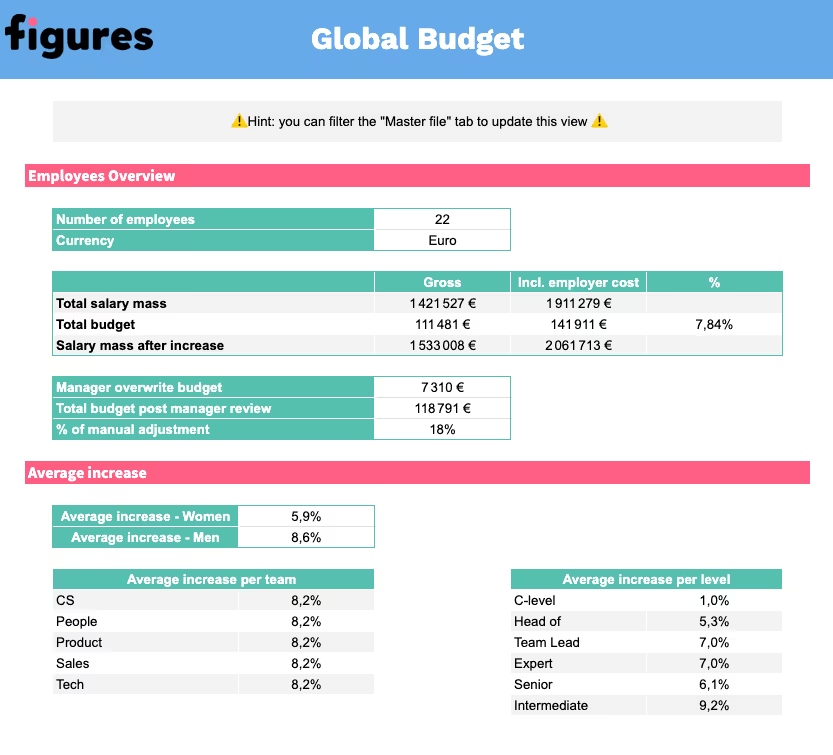
- A parameters tab for you to fine-tune the master information you want to apply afterwards: your merit increase matrix, inflation rates per country, exchange rates, etc. (check the following section to guide you on these parameters set up).
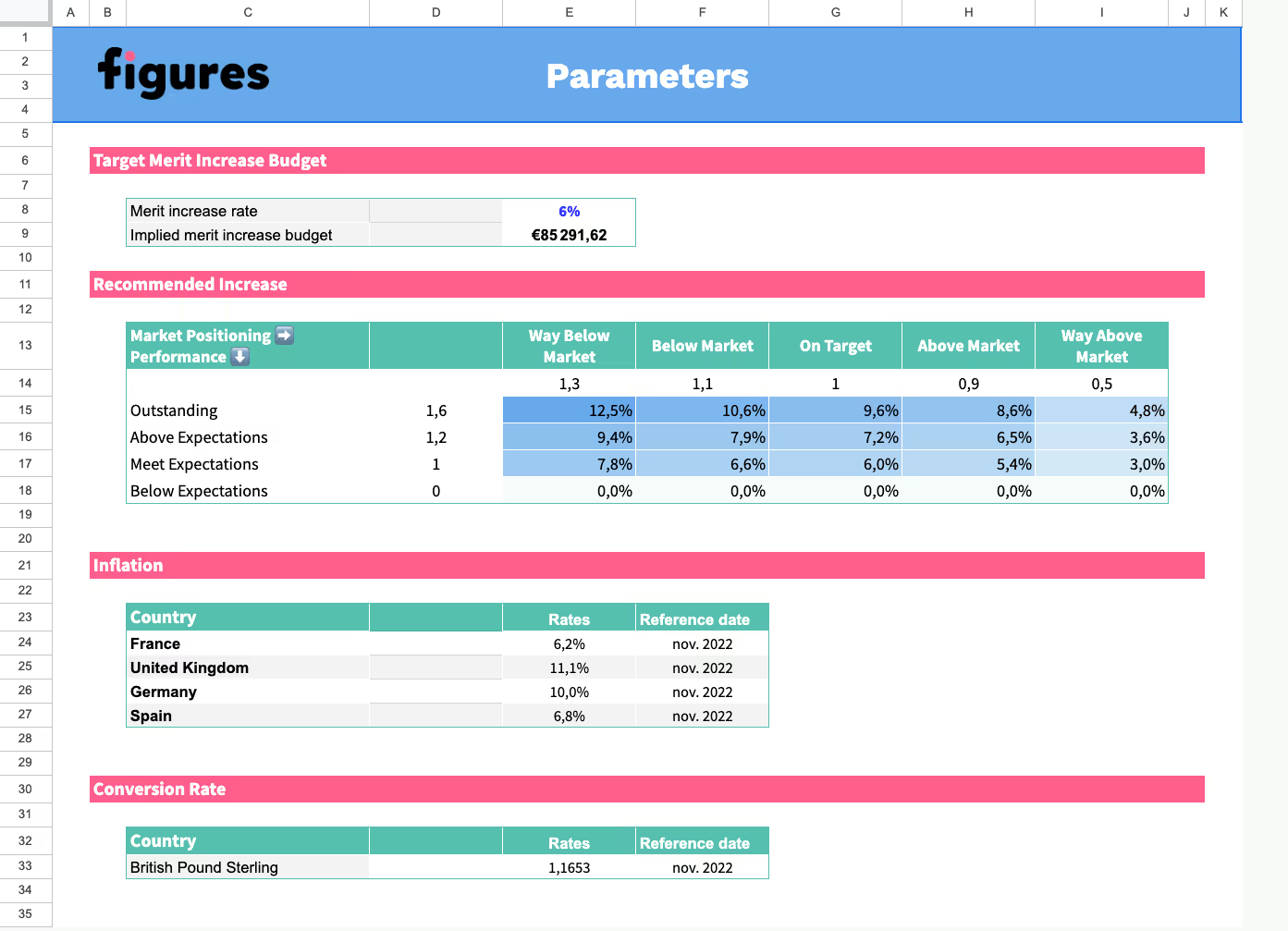
- The Master file tab is used to view individual simulations for each employee and process potential individual adjustments. If you’re using Figures, you can pull out lots of this tab’s information from the Budget Calculator, though you’ll still have to manually add some more information, such as the employee’s track record, if you want to.
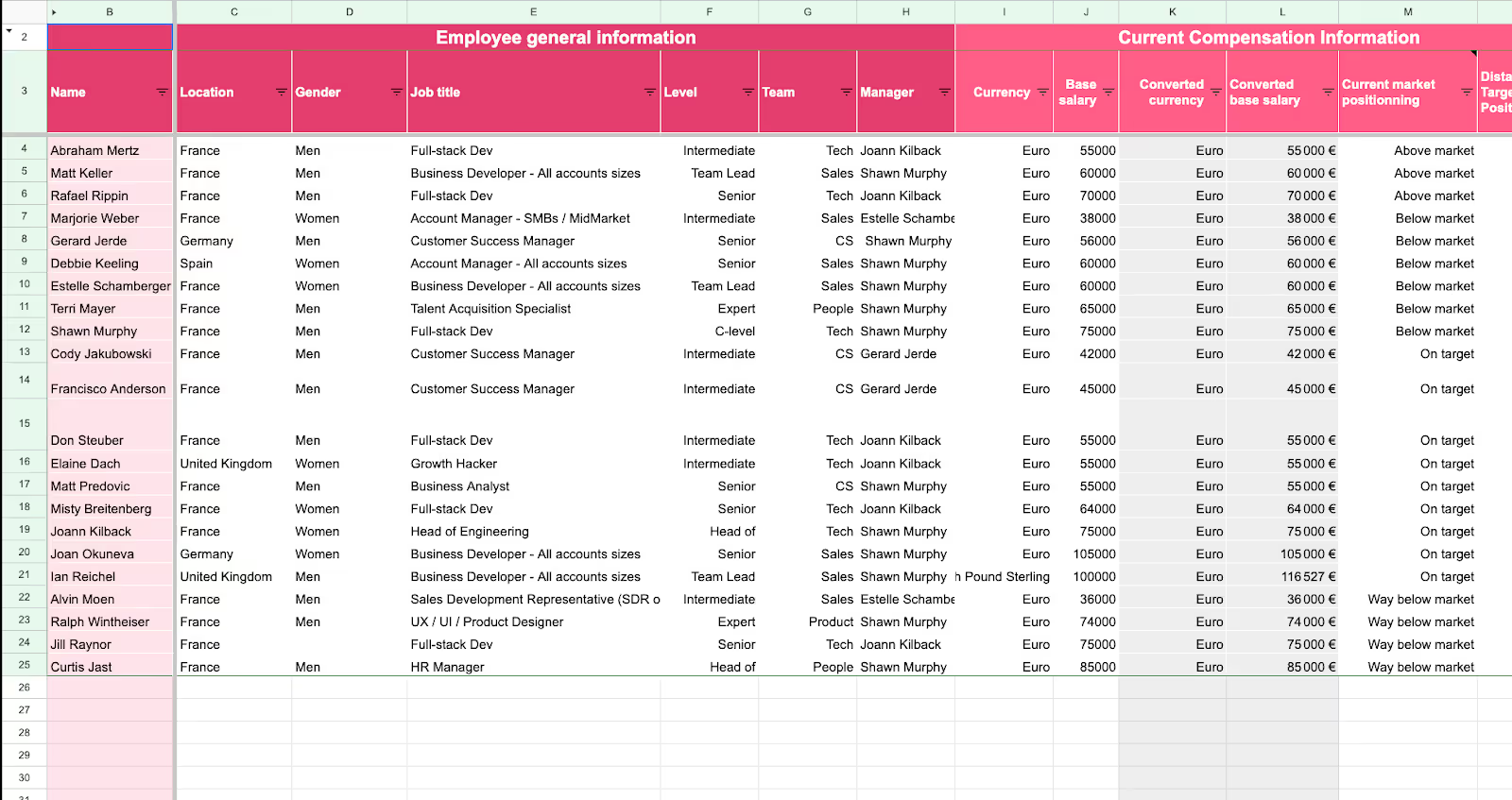
- A calibration tab to be used during your calibration meeting to finish your process.

3. How to define the annual compensation review process parameters
Now it’s time for some quick (or not so quick) maths.
Inflation rates
You may decide to compensate your team for current inflation, which will drive a flat % increase based on the employee’s location.
You can find updated inflation rates from many different sources (one of them here) and then decide, country by country, the associated salary increase from completely aligned to inflation to no compensation at all.
→ Make sure to list all countries where you have employees and the associated inflation rate in the parameters tab.
Exchange rates
You want to process your compensation review with a common currency all over the board for consistency issues; this parameter is relatively easy to set up.
→ List all currencies other than your reference one (€ in our template) and the exchange rate you want to apply.
Merit matrix
As explained earlier, you can conceive merit increase in two different ways, as shown in the sample charts below:

1. Considering only performance ratings - 1 rating = 1 increase %
With this methodology, two individuals in the same role with the same performance will receive the same percentage increase, which sounds fair (and is more appropriate than a pure discretionary increase).
If you look one step further, however, if their initial salaries were not the same for some reason, is it fair that they get a similar increase while one of them is better compensated than the other? We don’t think so. This is why we encourage you to…
2. Take performance ratings + market positioning into account to determine fair individual salary increases
This time, you make sure to take into account potential inequities you had in the past and correct them moving forward. You will reduce, if not delete, any salary gaps between two individuals with the same job, same level, and same level of performance.
Both ways work just fine, though we strongly advocate the second one, which ultimately tends to more fair compensation of your team, taking away possible entry biases (this person negotiated better than the other at offer time, this person had a higher salary before joining, etc.).
{{ cta }}
4. Collaborating with people managers and calibration for your salary review process
Managers review
Once you’ve set up general parameters and applied them to each individual, you’ll have a first version to be reviewed with people managers. The first thing you need to do is split your master file into sub-files or tabs to be shared with the manager, so they only have access to their team and sub-budget. You can use tools such as Split Sheet to build your sub-files more easily.
Then, depending on the size of your team and the level of autonomy, you can either:
- Plan a compensation review meeting with each manager to go over each employee and review step by step their:
Once they are aware of everything, managers have the power to overwrite the increase proposition if they want to. This could go both ways (higher or lower increase); in any case, we recommend limiting the number of manual adjustments so that, eventually, the fair system you build doesn’t lose credibility.
💡Pro tip: whether you’re helping them or not, make sure managers are giving factual and clear explanations for their overwrites; you need to be able to justify objectively any deviation from the standard process!
Finally, ensure your master file is updated once all managers’ reviews are done.
This way, you can keep track of the budget post managers’ adjustments and how many they have made. Overall, you need to know whether you’re still on track and everything is communicated clearly.
In our experience, the fewer manual adjustments you make, the more credible and reliable your automated system will be. A good practice would be to set a limit of up to 15% for manual adjustments and stick to it as much as possible.
Calibration
Calibration meetings are designed to discuss salary increases proposed by managers as a group, looking at sub-groups when needed: teams, levels, gender, etc.
Eventually, the goal is to ensure fairness all over the board and avoid potential biases: a manager being more generous/harsh than others, some team members being overly rewarded vs. others being limited for some subjective reasons, any discrimination, etc. This helps drive greater consistency in the compensation review process.
Methodology
There are lots of different ways to organise your calibration meeting, though here are some options that can make sense:
- In larger teams (at least 100 employees), you can run your review team by team; there will be enough employees at the same level for comparison to make sense. For smaller teams, you might want to start at step 2.
- Order employees per level + performance rating.
- Check the proposed final salary and look for discrepancies (same level / same performance level should land on a similar salary).
- Check the manager overwrites to explain, challenge, and validate them.
Using the budget dashboard is also a way for you to understand how you should organise your calibration meeting: Do you notice a gender gap in terms of average increase? Are the increases per level consistent enough? Does any team stand out compared to others?

Timing
Depending on how many people you have to review, plan enough time and be a ruthless timekeeper! Compensation discussion can easily drag on longer than needed. Designate a timekeeper, and be sure they’ll do their job. You shouldn’t spend time on every employee, but more on exceptions and outliers.
📊 Figures' guidance: calibration meetings average 3 minutes per employee when properly structured and timeboxed.
Accountability
Some managers may come out of the calibration meeting disappointed as they won’t always get what they expected for their team members; though, make sure they are accountable for the outcome and make it clear they will have to agree and commit.
The worst thing a manager can say is, "I wanted to give you more, but the calibration committee decided otherwise." This undermines the entire process and damages trust in your compensation system.
Ownership
Before starting the meeting, be sure everybody knows who will be the final decision maker. It can be the department head of each team member, the moderator, or the people team. No matter who it is, be sure it’s clear to everyone; it will save you some time afterwards.
Confidentiality
It may sound obvious to you, but it’s always worth mentioning; everything discussed in the calibration meeting remains within the calibration meeting. And outcomes should only be communicated once the People team has given their green light for communication.
Conducting effective salary review meetings
Once you've calibrated decisions, it's time for the conversations that matter most – actually delivering the news to your team. These meetings can be hard, but you can make them a lot easier if you get all your HR ducks in a row beforehand.
As proud compensation nerds at Figures, we recommend a 45-minute salary review meeting framework:
- Preparation and context setting: 5 minutes.
- Compensation decision communication: 10 minutes.
- Rationale and factors explanation: 10 minutes.
- Performance discussion and future goals: 10 minutes.
- Employee questions and feedback: 10 minutes.
Before each meeting, have ready:
- Employee's current salary and proposed new figure (e.g., £58,000 → £61,320).
- Market data supporting your decision.
- Performance review notes and specific examples.
- Budget constraints or company-wide context.
Anticipate common questions like: "Why isn't my increase higher?" or "How does this compare to my teammates?" Having data-backed answers ready prevents awkward silences and knife-sharp glances at future team gatherings.
If you’re looking for specific conversation scripts covering merit increases, no increases, and market adjustments, see our detailed guide on delivering compensation review results.
5. Communicating your compensation review process with employees
Compensation is an emotional topic for most people, so it’s very important for you to be controlled, managed, and prepared for different outcomes. Still, don’t forget you’re human first, and be brave enough to improvise if the situation calls for it. You can’t predict every single scenario.
Communication handled by the People team
Different teams have different responsibilities. After all, you wouldn’t force your IT department to throw the annual Christmas party. So, while most compensation and review conversations are handled by the direct managers, there are still some parts HR is responsible for. Here’s what that usually includes:
- Compensation philosophy and policy: take this occasion to remind them about the fundamentals of your compensation approach.
- Timeline: when are you running the review, and when will the outcomes be individually announced?
- Ownership: who is involved in the process, and who is the final decision maker? Who will then get back to them for the individual announcement?
- Parameters: depending on your transparency level, you can consider communicating about the overall budget, split between inflation/market/merit budgets, merit matrix, etc. The more you share with them in advance, the more accountable you are and the more reliable your system will be.
- Exceptions: except if you decide that there will be no exceptions, you should still remind everyone that some manual adjustments can be made, but for instance, you can commit to the fact that there will not be more than 10% of these.
If your communication process and systems are well-oiled, they will be your best ally.
Communication handled by the direct managers
Performance and compensation discussions are closely linked, but they should remain separate conversations. When talking about performance, focus solely on whether expectations are being met, why, and what the improvement plan looks like. Only move to compensation once the performance message has been properly absorbed.
However, no matter what news you’re sharing, always opt for face-to-face conversations (virtual or in-person) rather than written communication for salary announcements.
Now for some key preparation actions:
- Always commit, despite personal opinions – present a united front even if you disagree with the calibration committee's decision.
- Detail the increase structure so employees understand which portion comes from inflation, market adjustment, or merit.
- Prepare factual explanations for all decisions to avoid subjective or emotional responses.
- Schedule adequate time for questions and discussion rather than rushing through the conversation.
If your compensation system considers multiple variables (inflation, market, merit), employees should understand the breakdown. When your parameters are clear and transparent, there's little room for negotiation – which actually makes these conversations easier, not harder.
When everything is done, make sure to have a written follow-up to the announcement, whether an email, a formal information letter, or even a contract addendum. And if the discussion was heated, you might want to check in the following day to make sure the information has been understood and accepted.
Speaking of unpleasant conversations…
How to handle no-increase communications
Not every compensation review results in salary increases – and that's where many HR teams struggle most. These conversations require extra care and preparation.
No-increase templates communicate salary decisions with improvement paths. These templates explain decision rationale and future review timelines. No-increase letters maintain employee motivation despite disappointing news.
Key elements of no-increase communications:
- Opening with empathy for disappointment: Acknowledge that this isn't the news they hoped for.
- Clear rationale: Whether it's performance gaps, market position, or company budget constraints.
- Specific improvement path: Concrete steps they can take to earn an increase next time.
- Next review date: When can they expect another evaluation opportunity?
The goal isn't to sugarcoat reality – your employees are way too smart to fall for this. No, the actual goal is to maintain trust while providing a clear path forward. A well-handled no-increase conversation can actually strengthen the employee relationship if they feel heard and see genuine development opportunities ahead.
Ready to become a compensation review expert?
With all these tips and resources, we hope you will conduct your most efficient, fair, and successful compensation review ever! We’re rooting for you!
And if you need a bit more help or you’re feeling slightly lost between all the calculations, formulas, and laws, you can always count on Figures.
With our all-in-one compensation platform updated in real-time, expert HR and People insights, we want to make your job more efficient and empower more fair decisions.
- Follow us on LinkedIn to never miss an update.
- Learn more about compensation philosophy, the gender pay gap, and best practices on our blog.
- Check out our other product tutorials on YouTube.
And of course, if you want to get access to our full range of tools, ask for your demo of Figures today!
{{ cta }}
FAQ: Creating your compensation review process
How to write a compensation review?
Write compensation reviews by documenting performance ratings, market comparisons, and salary recommendations. Here's the step-by-step approach:
- Gather baseline data: Current salary, performance rating, and market benchmarks.
- Calculate proposed increase: Apply your merit matrix and market adjustments.
- Document rationale: Clear reasoning for the decision (performance, market position, budget).
- Include timeline: Effective date and next review cycle.
- Prepare talking points: Key messages for the manager delivering the news.
The most effective reviews combine objective data with clear explanations, making it easy for managers to communicate decisions confidently.
Why are salary reviews important?
Salary reviews ensure fair and competitive employee compensation. They help ensure fair and competitive compensation for employees, which is essential for attracting and retaining top talent.
Regular salary reviews demonstrate an organisation's commitment to rewarding employees' contributions and maintaining internal equity. They also help address any disparities and align salaries with market trends, promoting employee satisfaction and engagement.
How do salary reviews affect company culture?
Fair salary reviews build trust and demonstrate organisational values in action. When conducted fairly and transparently, they foster a sense of trust, fairness, and recognition among employees. This demonstrates that the organisation values its workforce and acknowledges their efforts, which can enhance employee morale, motivation, and loyalty.
"The biggest impact on company culture isn't the salary increase itself – it's whether employees trust the process behind it,"
Explains Virgile Raingeard, CEO of Figures and former HR leader. "When people believe their compensation is decided fairly and transparently, it creates psychological safety that extends far beyond pay discussions."
Conversely, if salary reviews are inconsistent or perceived as biased, it can lead to dissatisfaction, low morale, and a negative impact on the company culture.
How can you prepare for a salary review?
Preparation requires gathering market data, performance records, and budget parameters. Consider these steps:
- Gather relevant data: Collect market research, salary surveys, and industry benchmarks to understand the current compensation trends.
- Review employee performance: Evaluate individual performance, considering factors such as goals achieved, skills acquired, and overall contributions.
- Assess internal equity: Analyse salary ranges within the organisation to ensure consistency and fairness.
- Determine budgetary constraints: Consider the financial resources available for salary adjustments.
- Plan communication: Prepare a clear and transparent communication strategy to convey the salary review process, timeline, and expectations to employees.
What is the compensation cycle review?
A compensation cycle review is the systematic evaluation and adjustment of employee compensation within an organisation.
It typically involves assessing and updating salary structures, conducting salary reviews, and implementing changes based on various factors such as market conditions, employee performance, and budget considerations. The compensation cycle review ensures that salaries remain competitive, equitable, and aligned with the organisation's strategic goals.
How to evaluate your salary review process?
You can start by measuring fairness, market competitiveness, and employee satisfaction.
Consider these aspects:
- Clear criteria: Assess whether the criteria used to determine salary adjustments are well-defined, transparent, and consistently applied.
- Equity and fairness: Evaluate if the process ensures fairness and internal equity by considering factors such as performance, experience, and market value.
- Employee feedback: Gather feedback from employees to gauge their satisfaction with the process and perceived fairness of the outcomes.
- Market competitiveness: Compare your organisation's salary levels with industry benchmarks to ensure competitive compensation.
- Retention and engagement: Monitor employee retention rates and engagement levels to gauge the effectiveness of the salary review process in motivating and retaining talent.
Regularly reviewing and refining your salary review process is essential to ensure its effectiveness and alignment with the organisation's goals and values.
Summarize this article with AI
No time to read it all? Get a clear, structured, and actionable summary in one click.


.png)
.png)
.jpg)

